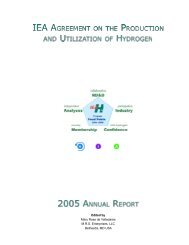Technology Status of Hydrogen Road Vehicles
Technology Status of Hydrogen Road Vehicles
Technology Status of Hydrogen Road Vehicles
Create successful ePaper yourself
Turn your PDF publications into a flip-book with our unique Google optimized e-Paper software.
The most abundant and accessible hydrogen-dense feedstocks are water, coal, oil and natural gas.<br />
.......<br />
Of course, fossil fuel hydrogen is not a clean, renewable resource. Most <strong>of</strong> the hydrogen research community<br />
agrees that eventually hydrogen should be produced from water. Nevertheless it may be easiest to sustain a<br />
transition to hydrogen by expanding commercially-available, relatively inexpensive production processes, such<br />
as the manufacture <strong>of</strong> H 2 from coal for many decades, environmental considerations aside......<br />
.......<br />
<strong>Hydrogen</strong> also can be produced from the gasification <strong>of</strong> biomass....<br />
However the biomass resource base, although renewable, is many times smaller than the coal resource base.<br />
.......<br />
For simplicity, this paper considers only the most abundant hydrogen feedstocks: coal to represent a low-cost<br />
base in the near-to-medium term, and solar water electrolysis as a low-environmental impact case in the longer<br />
term.<br />
.......<br />
Water can be decomposed thermally at temperatures above 2500 K.....(but) many researchers do not think<br />
thermochemical production is very promising, and favor electrolytic and photolytic water-splitting techniques<br />
instead..... In my analysis, I consider water electrolysis only...<br />
Non-fossil feedstocks should be used....<strong>of</strong> these, solar energy and nuclear energy are available in the long<br />
term.....; this cost analysis examines solar hydrogen.<br />
3. <strong>Hydrogen</strong> Distribution<br />
Typically, hydrogen would be transported from the site <strong>of</strong> production to end users as a gas, via pipeline.<br />
Ideally, the current natural gas system would be used for at least the initial stages <strong>of</strong> a transition to hydrogen.<br />
However, pure hydrogen reacts at the surface <strong>of</strong> certain pipeline steels, embrittling them and accelerating the<br />
growth <strong>of</strong> fatigue cracks.....(but) compounds can be added to hydrogen to inhibit embrittlement, (but) none<br />
is safe, inexpensive and effective. Otherwise, dedicated pipelines would have to be built.<br />
.......<br />
<strong>Hydrogen</strong> also could be shipped in liquid form, in 49 000 l tank trucks, 132 000 l rail cars, or, for short<br />
distances, in vacuum-jacketed pipelines.<br />
4. Vehicular Fuel Storage and Refueling<br />
<strong>Hydrogen</strong> may be stored on board a vehicle as a gas bound with certain metals, as a liquid in cryogenic<br />
containers, or as highly compressed gas (690 bar) in ultra-high-pressure vessels. Other forms <strong>of</strong> hydrogen<br />
storage, such as glass microspheres, cryoadsorbents, and liquid hydrides, are discussed in the literature...<br />
.......<br />
The metals most used in hydrides are iron, magnesium, nickel, manganese and titanium. Vehicular hydride<br />
storage systems are usually long thin hollow cylinders, tightly bundled, and pressurized with hydrogen to<br />
about 34 bar. When the vessel is charged, a good deal <strong>of</strong> heat is released... and during discharge the reaction<br />
is reversed and heat is required.<br />
.......<br />
The most serious shortcoming <strong>of</strong> hydrides is their low mass and volumetric energy density...The low mass<br />
density <strong>of</strong> most hydrides means that hydride vehicles are much heavier and less efficient than comparable<br />
gasoline or LH 2 vehicles, and are limited by storage weight to about a 150-300 km range.<br />
.......<br />
Hydrides are susceptible to contamination by impurities in the hydrogen gas.....(and) a 99.999% purity is<br />
necessary to insure that hydrides have relatively long lives.<br />
.......<br />
42













